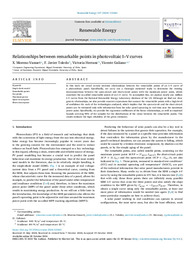Por favor, use este identificador para citar o enlazar este ítem:
https://hdl.handle.net/11000/34239Registro completo de metadatos
| Campo DC | Valor | Lengua/Idioma |
|---|---|---|
| dc.contributor.author | Moreno-Vassart, Xavier | - |
| dc.contributor.author | Toledo Melero, Fco. Javier | - |
| dc.contributor.author | Herranz Cuadrado, Maria Victoria | - |
| dc.contributor.author | Galiano, Vicente | - |
| dc.contributor.other | Departamentos de la UMH::Estadística, Matemáticas e Informática | es_ES |
| dc.date.accessioned | 2025-01-09T09:24:20Z | - |
| dc.date.available | 2025-01-09T09:24:20Z | - |
| dc.date.created | 2024 | - |
| dc.identifier.citation | Renewable Energy | es_ES |
| dc.identifier.issn | 1879-0682 | - |
| dc.identifier.issn | 0960-1481 | - |
| dc.identifier.uri | https://hdl.handle.net/11000/34239 | - |
| dc.description.abstract | In this work we reveal certain intrinsic relationships between the remarkable points of an I–V curve of a photovoltaic panel. Specifically, we carry out a thorough statistical study to determine the existing interconnections between the open-circuit and short-circuit points with the maximum power point, which constitute the so-called remarkable points of an I–V curve. To accomplish this, we analyse nearly one million I–V curves from the National Renewable Energy Laboratory database of the US. Although we find out clear generic relationships, we also provide concrete expressions that connect the remarkable points with a high level of confidence for each of the technologies analysed, which implies that the open-circuit and the short-circuit points can be estimated only with information from the solar panel operating in real time near the maximum power point. Specifically, we provide the regression coefficients of the linear relationships, as well as empirical bounds covering 95% of the samples for the distributions of the ratios between the remarkable points. The results indicate the high reliability of the given estimates. | es_ES |
| dc.format | application/pdf | es_ES |
| dc.format.extent | 9 | es_ES |
| dc.language.iso | eng | es_ES |
| dc.publisher | Elsevier | es_ES |
| dc.relation.ispartofseries | 237 | es_ES |
| dc.relation.ispartofseries | Part B | es_ES |
| dc.rights | info:eu-repo/semantics/openAccess | es_ES |
| dc.rights | Attribution-NonCommercial-NoDerivatives 4.0 Internacional | * |
| dc.rights.uri | http://creativecommons.org/licenses/by-nc-nd/4.0/ | * |
| dc.subject | Single-diode model | es_ES |
| dc.subject | Remarkable points | es_ES |
| dc.subject | Key points | es_ES |
| dc.subject | Maximum power | es_ES |
| dc.subject | Open-circuit point | es_ES |
| dc.subject | Short-circuit point | es_ES |
| dc.subject.other | CDU::5 - Ciencias puras y naturales::51 - Matemáticas | es_ES |
| dc.title | Relationships between remarkable points in photovoltaic I–V curves | es_ES |
| dc.type | info:eu-repo/semantics/article | es_ES |
| dc.relation.publisherversion | https://doi.org/10.1016/j.renene.2024.121661 | es_ES |

Ver/Abrir:
Moreno_Vassart_etAl_2024_Renew.Energy_237_121661.pdf
2,69 MB
Adobe PDF
Compartir:
 La licencia se describe como: Atribución-NonComercial-NoDerivada 4.0 Internacional.
La licencia se describe como: Atribución-NonComercial-NoDerivada 4.0 Internacional.
.png)